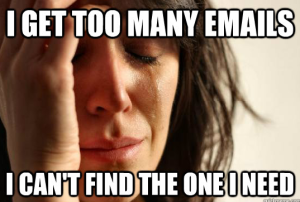DisOrganization
Have you ever been in a meeting where people are asked to locate information distributed months or years ago? Time is wasted as people search through electronic and paper file folders. Information resides in static silos than can be accidentally deleted with the click of a mouse. People who are new to the organization do not have access to the past, and information is lost with the departure of employees. A web log or blog provides a searchable repository of information that can be revisited as needed. It makes sense to use a blog for its intended purpose – to keep a log of information. A blog is not only an archive of information, it is a venue for an open exchange of ideas (Casey & Stephens, 2007).

First World Problem
Emergence of a Transparent Tech Plan
As discussed in The transparent library: turning “no” into “yes,” sometimes ideas are shot down because the “idea had been tried five years earlier (Casey & Stephens, 2007).” When this happens, we need to ask why the idea has surfaced again – perhaps the need still exists, or the workplace lacked resources to put a good idea into action. Either way, an open source of communication is needed to stop the cycle of rehashing the same issues ad nauseam.
After ruminating over the concept of transparency I decided that I would like to use social media to create a platform for information exchange at my workplace. Sample topics would include: 5-Year Plan, Conferences, WASC Accreditation, and Water Cooler. It is imperative that the intended audience and purpose of the blog is communicated to employees. Employees will need to know:
- What is the intended purpose of the blog?
- Is it a public blog, or internal?
- What are the expectations for grammar and netiquette?
- Is participation required, or optional?
The Culture of “No”
Sometimes I become obsessed with a new idea for which I craft a plan to bring the idea to fruition. Then I worry that dystopians will derail my plans. I have witnessed all of the following scenarios either personally or indirectly.
- I am inspired by new ideas learned at a conference!
- I am not asked to share information about the conference, and do not take initiative to share information.
- I am asked to present information in a short PowerPoint to document conference attendance. The End.
- “A committee forms to analyze the (idea), then a team comes together to write best practices, and then a workgroup begins a pilot program–and suddenly it’s 12 months later, and nothing has happened (Casey & Stephens, 2007, December 15).”

The Culture of No
Heed the Signs
Flash forward to a time when my envisioned blog debuts. While I may say, “I have a great idea! Come with me to blogland!” Others may hear, “You have been doing something wrong, I want you to change!” or “Here is more work for you – check mailroom, voicemail, email, and now blog daily!” Part of the problem with technolust for a new idea is that some employees will respond defensively, no matter the potential rewards. Failure can be averted giving due attention to the signposts along the way (Casey & Stephens, 2008). If I build the blog, it is imperative that I assess, evaluate, and modify the project as needed. Success is dynamic journey, not a static destination.

University of South Carolina Lancaster Medford Library’s Photos – Facebook page
References
Casey, M., & Stephens, M. (2008, December 15). The transparent library: six more signposts on the way [Web log post]. Retrieved fromhttp://www.libraryjournal.com/article/CA6618868.html
Casey, M., & Stephens, M. (2008, November 15). The transparent library: six signposts on the way [Web log post]. Retrieved from http://www.libraryjournal.com/article/CA6611609.html
Casey, M., & Stephens, M. (2008, April 15). The transparent library: measuring progress [Web log post]. Library Journal. Retrieved from http://www.libraryjournal.com/article/CA6547089.html
Casey, M., & Stephens, M. (2007, May 1). The transparent library: turning “no” into “yes” [Web log post]. Library Journal. Retrieved from http://www.libraryjournal.com/article/CA6435552.html
Casey, M., & Stephens, M. (2007, December 15). The transparent library: a road map to transparency [Web log post]. Retrieved from http://www.libraryjournal.com/article/CA6510682.html
Dockett, E. (2011). What they don’t teach you in library school. Chicago: American Library Association.
Quickmeme. (2013). First world problems [Meme generator]. Retrieved from http://www.quickmeme.com/First-World-Problems/




